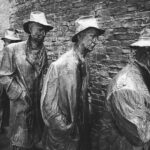 Unsplash/Kateryna Hliznitsova
Unsplash/Kateryna HliznitsovaThe 1980s were a different world for British schoolchildren. Uniforms were stricter, punishments were harsher, and rules often reflected a mindset that seems almost unthinkable by today’s standards. Many of these practices were enforced without much question, even though they’d raise serious concerns now around safety, dignity, and child welfare. Looking back, it’s astonishing what passed as normal. The culture was largely shaped by deference to authority, a strong emphasis on discipline, and a belief that conformity was necessary to prepare young people for adulthood. Here are some of the most eyebrow-raising school rules from 1980s Britain that would never fly today.
Corporal punishment was still legal
Until 1987, teachers in England and Wales were legally allowed to administer corporal punishment in state schools. That included caning, slapping with rulers, or even being hit with slippers. Some schools had designated punishment books that logged how many “stripes” or “swats” a child received for various infractions. Private schools held on to this practice even longer, some until the early 2000s.
It wasn’t just for serious misbehaviour, either. Talking in class, being late, or even answering back could result in physical punishment. Today, this would be viewed as a clear breach of safeguarding and child protection standards. It’s difficult to imagine how normalised this was just a few decades ago.
You had to ask permission to go to the toilet.
Toilets were not seen as a basic need during lessons—they were a privilege. If you needed to go during class time, you had to raise your hand and ask, sometimes with your entire class listening. And even then, the answer was often “no.”
There are countless stories of children being forced to wait until break time, even in discomfort. In some cases, accidents happened, and pupils were left humiliated. Today, denying children access to toilets without a valid reason would likely be seen as both a health issue and a failure of duty of care.
You’d sometimes get detention for untidy handwriting.
Neat handwriting was considered a sign of discipline and intelligence, and any deviation could land you in trouble. If your joined-up writing wasn’t up to standard, you could be kept in at lunch or after school to write lines or copy out handwriting drills.
Students were even required to “earn” their pens by proving they could write tidily in pencil first. In today’s education system, where learning differences like dyslexia and dyspraxia are better understood, this kind of punitive approach to penmanship would be considered outdated and inappropriate.
Girls had strict skirt length inspections.
Girls’ uniforms were often policed in a way that would raise serious safeguarding concerns today. Teachers sometimes kept rulers to measure skirt length, checking that it wasn’t above the knee. If it was, the student could be sent home or made to change into a spare item from lost property.
The focus on modesty disproportionately targeted girls, often shaming them for what they were wearing rather than addressing the culture that judged them for it. In modern schools, such scrutiny would likely be seen as intrusive and potentially discriminatory.
Boys weren’t allowed long hair.
Gender expectations were tightly enforced in school rules. While girls were penalised for showing too much skin, boys could be sent home for growing their hair too long. Some schools had explicit rules against “feminine” styles, including ponytails, fringes, or dyed hair.
Even facial hair was forbidden in many schools, with boys told to shave regularly or face punishment. Today, personal grooming is far more flexible, and rules that discriminate based on gender presentation would be challenged under equalities legislation.
Left-handed students were still corrected.
Although far less common than in earlier decades, the idea that left-handedness needed to be “fixed” still persisted in some classrooms in the 1980s. Teachers might discourage children from using their dominant hand or force them to switch.
This often resulted in discomfort, confusion, and lasting frustration. Today, such actions would be seen as educational malpractice. Schools now support a wider range of learning needs and neurodiversity rather than trying to suppress them.
No talking in the lunch queue.
Lunchtime was anything but relaxed. In many schools, the lunch queue was a silent affair. Pupils were told to stand in single file without talking, and any whispering could earn a stern warning or a detention.
Some schools even had monitors or prefects whose job was to report “talkers” to staff. This kind of enforced silence would be considered excessive now, especially in a setting that should support social interaction and emotional development.
You had to do PE, no matter what.
PE was compulsory, and any excuse was viewed with suspicion. Forgot your kit? Too bad—you’d be made to participate in your vest and pants, or forced to wear a spare uniform from the school cupboard, which was often ill-fitting and unwashed.
Claims of illness were dismissed unless accompanied by a note from home, and even then, some teachers pushed back. Today, this would raise red flags around hygiene, dignity, and basic respect for student wellbeing.
Punishments included standing outside facing a wall.
One common punishment involved being sent out of class to stand in the corridor, sometimes with your nose to the wall. It wasn’t just about removing a disruptive pupil; it was designed to humiliate. Students were often left outside for entire lessons, visible to everyone who walked past. In modern classrooms, this kind of punishment would be considered inappropriate and a potential breach of a child’s right to education.
Strict uniform inspections were held, including sock colour and shoe type.
Uniform rules were enforced with forensic precision. Schools checked everything—skirt length, sock colour, tie knot, and shoe type. Black trainers weren’t allowed, even if they looked identical to leather shoes. White socks with dark shoes were a definite no.
In some schools, failing a uniform inspection meant being sent home or placed in isolation. While many schools still have dress codes, they’re far more likely to be applied with flexibility and understanding. Today, such rigid uniform policing would be considered over-the-top.
Assembly lectures on ‘proper behaviour’ happened often.
Assemblies in the 1980s were not just about announcements or school spirit. They were often platforms for discipline. Entire year groups or schools would be gathered so senior staff could deliver moralistic speeches or stern warnings. Students were sometimes singled out in front of their peers, with names called and behaviour publicly addressed. This sort of public shaming would now be seen as counterproductive and harmful to student mental health.
There was to be silence during tests, with no exceptions.
Exams and even minor classroom tests were treated with a level of formality that bordered on absurd. Silence was absolute, and any attempt to ask a question, no matter how small, could be seen as “cheating” or disrupting others.
There was little room for clarification, reassurance, or consideration of learning needs. Today, classroom assessments are far more inclusive, with options for extra time, assistive technology, and support for students with anxiety or special educational needs.
Writing lines as punishment was common.
“I must not talk in class” written 100 times was a standard punishment. Sometimes it was done during break, sometimes after school. The act was meant to reinforce the rule through repetition, but in reality, it often just wasted time.
While it wasn’t the harshest form of discipline, it did little to address the reasons behind a child’s behaviour. Modern behaviour policies are more likely to focus on reflection, restorative conversations, or pastoral intervention.
The 1980s weren’t that long ago, but looking back at some of these school rules, it’s clear just how much has changed.
What was once considered part of a “tough love” approach is now recognised as damaging or unnecessary. Schools today are still places of structure and discipline, but they’re also expected to be spaces where children feel safe, respected, and supported. Progress hasn’t been perfect, but thankfully, the days of corporal punishment, enforced silence, and humiliation-as-discipline are mostly behind us.



